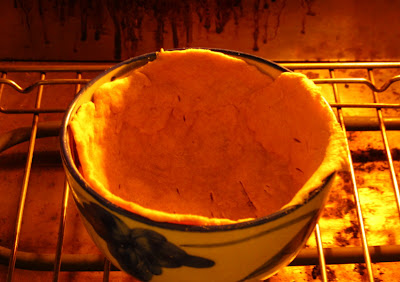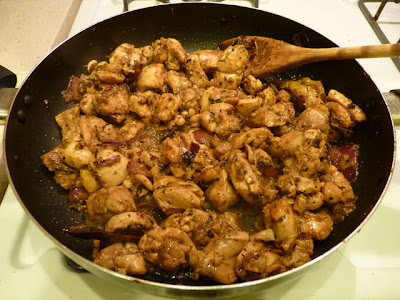I've been making a lot of in-and-out dishes lately. That is, dishes that require you to zoom into the kitchen, do some quick stirring, and zap back out. This is One Such. Here's the how-to:
Take ten or twelve shelled and be-headed (and de-tailed, if you like) prawns. Not enormous ones. If they are large, cut them along the vein to make one into two. Wash and clean then, then leave them alone to dry. No marinade! Now, prep the other ingredients thus: mince about six cloves of garlic. Aww, no no, stick to three if that's all you can handle. Chicken. Yes. Anyway. Take six cloves of garlic. Peel and mince them. Now, either make a paste of dry red chilies (with a green thrown in to take the edge off), or, if you're sensible and avoid dry red chilies, just wash and chop about three green chilies (unless, that is, you're all delicate like. In which case you'd best abandon this ship now. It's going to get worse). Finally, chop a couple of shallots/green onions, stalk and all.
So, after you're all prepped, heat a tablespoon of butter in a wok.
Aww, I kid! Sunflower oil will do just fine.
No, really. One tablespoon of butter. In this, when warm and liquid, add the minced garlic. When fragrant, add the chilly paste, or the chopped green chilies. Stir quickly for about a minute. Add the chopped green onions. Just the onion parts, mind. Show some more wristwork. Then, stir in the prawns and if you're flame wasn't already on simmer, do it ASAP or the prawns will harden. After lightly tossing the prawns in the garlicky, warm butter and watching their juices mix with it for a minute or so, add a cup of fresh or heavy cream. If using fresh cream, whisk it lightly before adding to the wok. Stir this well. When it's been folded in well, add the green stalks of the green onion, toss, taste for salt and heat, add chili flakes if you want, and take it off the flame.
NOTE: this sauce can stand the addition of a lot of mild-flavoured cheese, but I'm watching out for my poor ole heart these days, so I skip it. No reason why you should, though :-)
This sauce is ready to eat straight off the wok, with a baked potato on the side or a small bowl of rice. It goes wonderfully well with pasta of most descriptions, too. However, I prefer it best baked. You can either bake it on a layer of thinly sliced potatoes, topped with cheese or breadcrumbs (or both), or you could bake the sauce-mixed-pasta, with a similar topping. I've even had it baked on top of a layer of mashed potatoes. It was divine.
Go on then, try it. And tell me how it was. Utterly delicious, or merely very good? ;-)
Take ten or twelve shelled and be-headed (and de-tailed, if you like) prawns. Not enormous ones. If they are large, cut them along the vein to make one into two. Wash and clean then, then leave them alone to dry. No marinade! Now, prep the other ingredients thus: mince about six cloves of garlic. Aww, no no, stick to three if that's all you can handle. Chicken. Yes. Anyway. Take six cloves of garlic. Peel and mince them. Now, either make a paste of dry red chilies (with a green thrown in to take the edge off), or, if you're sensible and avoid dry red chilies, just wash and chop about three green chilies (unless, that is, you're all delicate like. In which case you'd best abandon this ship now. It's going to get worse). Finally, chop a couple of shallots/green onions, stalk and all.
So, after you're all prepped, heat a tablespoon of butter in a wok.
Aww, I kid! Sunflower oil will do just fine.
No, really. One tablespoon of butter. In this, when warm and liquid, add the minced garlic. When fragrant, add the chilly paste, or the chopped green chilies. Stir quickly for about a minute. Add the chopped green onions. Just the onion parts, mind. Show some more wristwork. Then, stir in the prawns and if you're flame wasn't already on simmer, do it ASAP or the prawns will harden. After lightly tossing the prawns in the garlicky, warm butter and watching their juices mix with it for a minute or so, add a cup of fresh or heavy cream. If using fresh cream, whisk it lightly before adding to the wok. Stir this well. When it's been folded in well, add the green stalks of the green onion, toss, taste for salt and heat, add chili flakes if you want, and take it off the flame.
NOTE: this sauce can stand the addition of a lot of mild-flavoured cheese, but I'm watching out for my poor ole heart these days, so I skip it. No reason why you should, though :-)
This sauce is ready to eat straight off the wok, with a baked potato on the side or a small bowl of rice. It goes wonderfully well with pasta of most descriptions, too. However, I prefer it best baked. You can either bake it on a layer of thinly sliced potatoes, topped with cheese or breadcrumbs (or both), or you could bake the sauce-mixed-pasta, with a similar topping. I've even had it baked on top of a layer of mashed potatoes. It was divine.
Go on then, try it. And tell me how it was. Utterly delicious, or merely very good? ;-)

















































